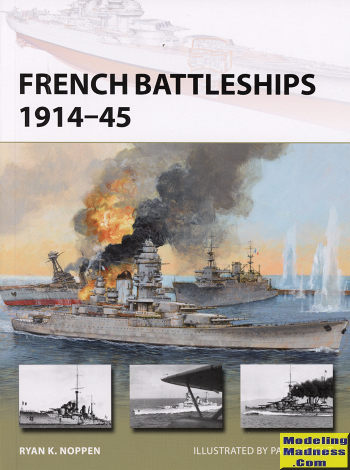 This
next title in Osprey's New Vanguard series covers French battleships of WWI and
WWII. It was the French who built the first ironclad ocean going warship and it
is fairly amazing that they were not in the forefront of battleship development.
Indeed, they seemed to have rested on their laurels and during the naval
build-up prior to WWI, they had very little to offer in the way of heavy ships.
This
next title in Osprey's New Vanguard series covers French battleships of WWI and
WWII. It was the French who built the first ironclad ocean going warship and it
is fairly amazing that they were not in the forefront of battleship development.
Indeed, they seemed to have rested on their laurels and during the naval
build-up prior to WWI, they had very little to offer in the way of heavy ships.
The French decided they really did not need much of an ocean-going navy
and concentrated on littoral vessels to take care of their naval needs. While
battleships were built, they were generally a generation behind. They did not
fall in line with the dreadnaught class of ships with single large calibre
armament, and so entered WWI with a fairly second-rate navy compared to the
British and Germans. The French battle fleet was geared during the war, to
facing the Austro-Hungarian fleet. However, the AH fleet never sortied so the
French simply kept up a frustrating blockade on the Adriatic; years of inaction,
basically.
After the war, the various treaties reduced the available tonnage of
naval vessels built by those who signed the treaty. Even though they were
allowed larger ships, the French did not have the dry docks capable of ships the
same size as others. This resulted in the construction of ships where all the
main armament was in the front of the ship. It was felt that their battleships
would be mainly used for chasing the German panzershiffs like the Graf Spee so
rear main guns weren't needed.
When WWII broke out, the French were more concerned with Italy as their naval
construction had lagged seriously behind plans and their newest ships were not
fully constructed. One, the Dunkerque, wasn't commissioned until after
the war while the Jean Bart was never fully completed. Some French ships did do
battle with Allied navies, but all were done when the ships were in port at
Caseblanca and Dakar, so were effectively floating gun emplacements. After 1943,
the Richelieu was the most active of their battlehips, performing shore
bombardment in the Far East with the Royal Navy.
I have to say this is one of the better books in the series (and they
are all good), as it provides information to me on a subject of which I had very
little actual information. French military equipment is not well written about
outside the country and this one does a superlative job of covering the design
and deployment of some fairly interesting ship types. Thanks to the great
illustrations and the well-chosen period photos, we get a good look at some
pretty neat ships and a fairly frustrating war record to boot. Pick it up.
You'll not be disappointed.
February 2019
For more on the complete line of Osprey books,
visit http://ospreygrp.com. In the US, it is
Osprey Direct at 44-02 23rd St, Suite 219, Long Island City, NY 11101., where you can
get a catalogue of available books.
If you would like your product reviewed fairly and
fairly quickly, please
contact
the editor or see other details in the
Note to
Contributors.
 This
next title in Osprey's New Vanguard series covers French battleships of WWI and
WWII. It was the French who built the first ironclad ocean going warship and it
is fairly amazing that they were not in the forefront of battleship development.
Indeed, they seemed to have rested on their laurels and during the naval
build-up prior to WWI, they had very little to offer in the way of heavy ships.
This
next title in Osprey's New Vanguard series covers French battleships of WWI and
WWII. It was the French who built the first ironclad ocean going warship and it
is fairly amazing that they were not in the forefront of battleship development.
Indeed, they seemed to have rested on their laurels and during the naval
build-up prior to WWI, they had very little to offer in the way of heavy ships.